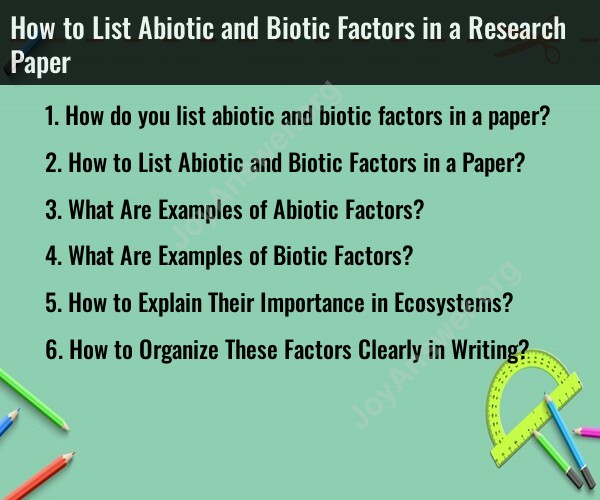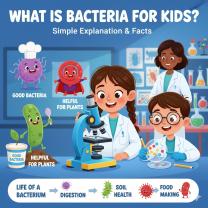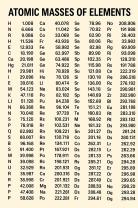How do you list abiotic and biotic factors in a paper?
When you’re writing a research paper that discusses abiotic (non-living) and biotic (living) factors, the goal is to present them clearly, logically, and in a way that supports your study’s focus.
Here’s how you can do it effectively:
1. Decide Where They Belong in Your Paper
Introduction/Background
If your research hinges on environmental context, you can introduce abiotic and biotic factors early to frame your study.Methods
If you measured them as part of your study, list them here along with data collection methods.Results
Present your measured factors in tables/figures with relevant units and statistics.Discussion
Relate how these factors influenced your findings.
2. Organize by Category
It’s best to separate abiotic and biotic factors so readers can quickly distinguish them.
Example Structure:
Abiotic factors: temperature (°C), pH, dissolved oxygen (mg/L), light intensity (lux), soil moisture (%), salinity (ppt).
Biotic factors: plant species richness, insect abundance, predator-prey ratios, microbial diversity.
3. Use a Table or Bulleted List
Tables make your lists more compact and scannable.
Example Table:
| Factor Type | Factor | Measurement Method / Unit |
|---|---|---|
| Abiotic | Temperature | Digital thermometer (°C) |
| Abiotic | pH | pH meter |
| Abiotic | Light intensity | Lux meter (lux) |
| Biotic | Bird species count | Point count survey (number) |
| Biotic | Leaf area index | Quadrat sampling (m²/m²) |
4. Keep It Relevant
Only list factors that:
Were measured or observed in your study
Have clear significance to your research question
Can be supported with data or credible sources
5. Maintain Consistent Style
Use parallel phrasing (e.g., “temperature,” not “the temperature of the water” unless detail is needed).
Group similar factors together.
Use scientific units consistently.
How to List Abiotic and Biotic Factors in a Paper?
When writing a paper, it's essential to present abiotic and biotic factors in a clear and organized manner. The most effective way is to dedicate separate sections to each type. Using a list format, like bullet points, under a bold heading for each category, makes the information easy to scan and digest. For instance, you can use headings like "Abiotic Factors" and "Biotic Factors" to guide your reader. You should also provide a brief introductory sentence for each list, explaining what the items represent.
What Are Examples of Abiotic Factors?
Abiotic factors are the non-living components of an ecosystem that influence the living organisms within it. They are the physical and chemical conditions that set the stage for life. Key examples of abiotic factors include:
Sunlight: The primary energy source for most ecosystems, essential for photosynthesis.
Water: A fundamental necessity for all known forms of life.
Temperature: The range of thermal conditions that an organism can tolerate.
Soil: The composition of the ground, including its pH, mineral content, and texture.
Air: The atmospheric gases, such as oxygen, carbon dioxide, and nitrogen, that are crucial for respiration and other biological processes.
Climate: The long-term weather patterns of a region, including precipitation and seasonal changes.
What Are Examples of Biotic Factors?
Biotic factors are all the living or once-living components of an ecosystem. They are the organisms that interact with each other and their environment. These interactions define the structure and function of the ecosystem. Examples of biotic factors are:
Producers: Organisms like plants and algae that create their own food using photosynthesis. They form the base of the food chain.
Consumers: Animals that obtain energy by eating other organisms. This category includes herbivores (plant-eaters), carnivores (meat-eaters), and omnivores (both).
Decomposers: Organisms like fungi and bacteria that break down dead organic matter, returning essential nutrients to the soil.
Competitors: Organisms that vie for the same limited resources, such as food, water, or territory.
Symbiotic Organisms: Organisms that live in close association with one another, such as in parasitic, mutualistic, or commensal relationships.
How to Explain Their Importance in Ecosystems?
To explain the importance of these factors, you must highlight their interdependence. Neither set of factors can exist without the other. You can start by explaining how abiotic factors, such as sunlight and water, provide the essential resources that biotic factors, like plants, need to survive.
Next, illustrate how biotic factors, in turn, shape and influence the abiotic environment. For example, decomposers enrich the soil with nutrients, and plants can alter the temperature and moisture levels of the area around them. A healthy ecosystem is a delicate balance, and a change in one factor—whether a new predator (biotic) or a drought (abiotic)—can have a cascading effect on all others.
How to Organize These Factors Clearly in Writing?
Effective organization is key to a high-quality paper. A suggested structure is:
Introduction: Begin with a clear definition of abiotic and biotic factors.
Abiotic Factors Section: Use a dedicated heading and an organized list to detail the non-living components.
Biotic Factors Section: Use a separate heading and list to explain the living components.
Interaction Section: Create a new heading like "The Interplay of Abiotic and Biotic Factors" to discuss how they influence one another. This is where you can showcase your understanding of ecosystem dynamics.
Conclusion: Summarize the key points and reiterate why understanding both sets of factors is crucial for studying any ecosystem.
This structure allows for a comprehensive, logical, and easy-to-follow presentation of the information, which is essential for a high-quality academic paper.













